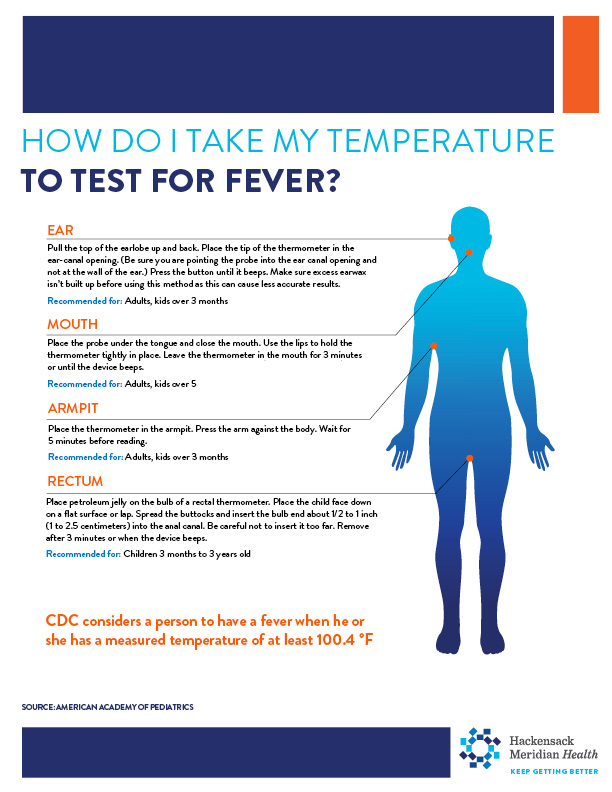How to Take Your Temperature to Check for a Fever

March 31, 2020
What is a fever?
A fever is the body’s way of warning you that something is off and can be a sign that your body is trying to fight an illness or infection. “For COVID-19, a high fever can be a presenting symptom, however there are other viruses to consider if fever is the only symptom,” says Renee Dougherty, D.O., a primary care physician with Hackensack Meridian Medical Group.
“Influenza is still prevalent and something to be considered in a patient with a fever. Additionally, some bacterial infections, such as strep throat can cause a fever as well, although additional symptoms are normally present.”
The CDC considers a person to have a fever when he or she has measured temperature of 100.4°F (38°C).
You’ve probably checked your temperature before and using a thermometer is a simple process, but do you know how to do it effectively?
What kind of thermometer should I use to take my temperature?
The type of thermometer to use depends on age. According to the American Academy of Pediatrics (AAP) using a rectum thermometer is what is recommended for infants and small children since they cannot hold a thermometer safely in their mouth. Children ages 4 and above and adults can use oral thermometers.
“It is important to note which thermometer is which, rectal thermometers should be designated as rectal only, and not interchanged to be used orally,” points out Dr. Dougherty. Forehead thermometers are another option as well, although most are substantially more expensive than an oral thermometer. There are utilized more so with young children, as they might find it difficult to use an oral thermometer.
How do I take my temperature to check for a fever?

- Based on the guidelines from the American Academy of Pediatrics (AAP):
- Mouth: Place the probe under the tongue and close the mouth. Use the lips to hold the thermometer tightly in place. Leave the thermometer in the mouth for 3 minutes or until the device beeps.
- Rectum: Place petroleum jelly on the bulb of a rectal thermometer. Place the child face down on a flat surface or lap. Spread the buttocks and insert the bulb end about 1/2 to 1 inch (1 to 2.5 centimeters) into the anal canal. Be careful not to insert it too far. Remove after 3 minutes or when the device beeps.
- Armpit: Place the thermometer in the armpit. Press the arm against the body. Wait for 5 minutes before reading.
- Ear: Pull the top of the earlobe up and back. Place the tip of the thermometer in the ear-canal opening. (Be sure you are pointing the probe into the ear canal opening and not at the wall of the ear.) Press the button until it beeps. Make sure excess earwax isn’t built up before using this method as this can cause less accurate results.
What’s the best way to clean a thermometer when I’m done?
Always clean your thermometer before and after using cool, soapy water or rubbing alcohol. Ear thermometer tips can be swiped with alcohol. Make sure to check the directions on the packaging to see how the manufacturer says the device should be cleaned.
When should I see a doctor about my fever?
The CDC recommends seeing your doctor if you experience one or more of the following:
- Temperature higher than 101°F that lasts more than 2 days or fails to respond at least partly to treatment
- Temperature higher than 103°F under any condition
- Headache with stiff neck
- Severe coughing or vomiting
- Pain taking a deep breath or difficulty breathing
- Facial pain
- Skin rash
- Unexplained bruising or bleeding
- Persistent diarrhea
- Yellow or green discharge from the nose
Next Steps & Resources:
- Meet our clinical contributor: Renee Dougherty, D.O.
- To make an appointment with Dr. Dougherty or a doctor near you, call 800-822-8905 or visit our website.
- Learn more about our Keeping America Safe program.
- CDC
- WHO
The material provided through HealthU is intended to be used as general information only and should not replace the advice of your physician. Always consult your physician for individual care
I Think I Have Coronavirus, Now What?

If you think you’ve been exposed to COVID-19 or are developing symptoms associated with the illness, follow these steps to help protect yourself and others from getting sick. If you...
6 Tips to Wash Your Hands the ‘Right’ Way

The most important part to remember is that you use clean, running water to wash your hands.

When to Seek Care for a Fever
A breakdown of when adults and children should seek care from a doctor if you have a fever.

Reduce Your Fear of Needles
A fear of needles can seem debilitating. Here are some tips to help overcome the phobia.

A Simple Breakdown of the Ingredients in the COVID Vaccines
If you’re among the many wondering “what’s actually in it?” and, “is it safe to receive the injection?”, read on.

How to Prepare for a COVID Test
With demand for testing high, planning ahead should make your experience go more smoothly.
